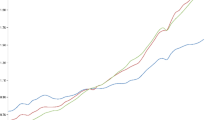Abstract
The purpose of this article is to make a distinction between (a) a society's ability to generate a scientific and technological potential (generativity), (b) the potential itself and (c) the country's capacity to absorb or receive scientific and technological research results (respectivity). These three complexes are represented by joint indicators covering both levels and structures. A comparison of 30 developing countries (DC) shows, inter alia, that: (a) the polarisation in economic development of the countries considered confirms the view that the future of national development is linked to the scientific and technological potential, (b) joint indicators can interpret better than a comparison of pairs of single indicators, (c) countries with comparable levels of the three capacities (generativity, R & D potential and receptivity) differ mostly in the structures. These structures seem to determine the differences in the use of the capacities, (d) the level of R & D potential is related more closely to the country's ability to absorb scientific and technological results than with its resources for building up this potential.
Similar content being viewed by others
References
H. Morita-Lou (Ed.),Science and technology Indicators for Development, Boulder and London 1985, P. 15. See also: Indicators of Measurement of Science and Technology on socio-economic Development Objectives. Report of the Panel of Specialists, Graz/Austria 1984,Scientometrics, 6 (1984) 449.
J.D. Frame. Measuring scientific activity in lesser-developed countries. In:Scientometrics, 2 (1980); 133Z. Gostkowsky, Integrated approach to Indicators for science technology. Office of Statistics, CSR-S-21. UNESCO, Paris 1986. Financial Resources for Fundamental Research. Office of Statistics, CSR-S-23. UNESCO, Paris 1988.
An Introduction to Policy Analysis in Science and Technology, UNESCO Series Science Policy Studies and Documents, No. 46, Paris 1979, P. 33.
Aktuelle theoretische und Praktische Probleme der Nutzung und Entwicklung des Wissentschaftspotentials. Kolloquien des Instituts für Theorie, Geschichte und Organisation der Wissenschaft der AdW der DDR, Heft 29, Berlin 1982, PP. 15–20.
Estimation of human and financial resources devoted to R & D at the world and regional level. Office of Statistics, CSR-S-7. UNESCO, Paris 1979.
N. Konrad, D. Wahl, Wissenschaftlich-technische Potentiale in Entwicklungsländern als nationaler und außenwirtschaftlicher Faktor.Asien, Afrika, Lateinamerika, Berlin, 13 (1985) 6, P. 952–965.
P.cit., P. 3.
UNESCO Statistical Year-book, Paris 1982, 1983, 1984, 1985 and 1986, Tables 5.1. till 5.17.
UNCTAD Handbook of International Trade and Development Statistics, New York, 1983, 1984, 1985, 1986, 1987, Tables 5.1., 6.1., 6.9., 7.2.
World Development, Report, Washington, 1981, 1984, 1985, 1986, Table 1, 3, 16, 21, 22.
South, London, Volumes 1985 and 1986.
UNIDO Global report, Statistical annex, Vienna 1985, 1986.
T. Braun, W. Glänzel, A. Schubert, One more Version of the facts and figures on Publication ontput and relative citation impact of 107 countries 1978–1980,Scientometrics, 11 (1987) 11.
Author information
Authors and Affiliations
Rights and permissions
About this article
Cite this article
Konrad, N., Wahl, D. Science, technology and development indicators for third world countries—Possibilities for analysis and grouping. Scientometrics 19, 245–270 (1990). https://doi.org/10.1007/BF02095351
Received:
Issue Date:
DOI: https://doi.org/10.1007/BF02095351




